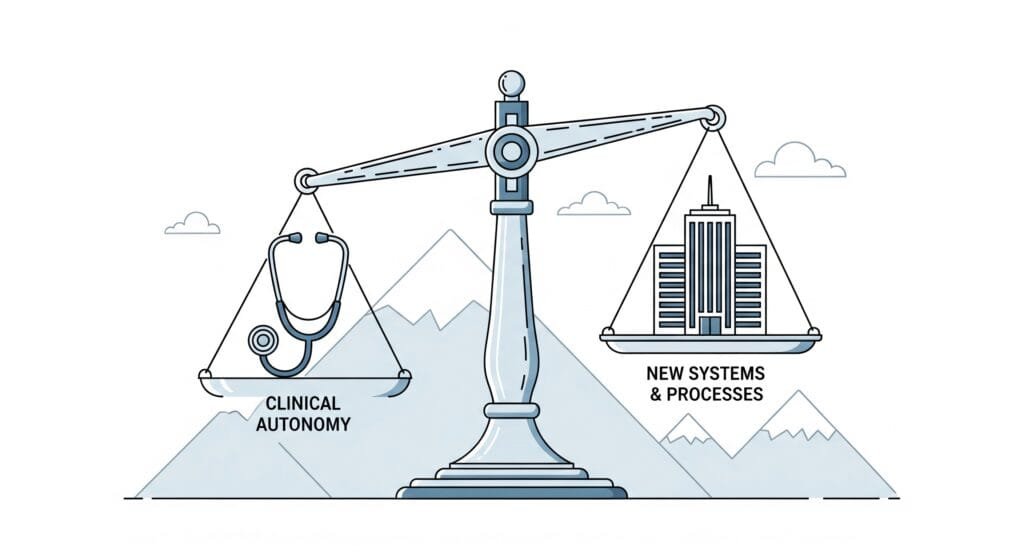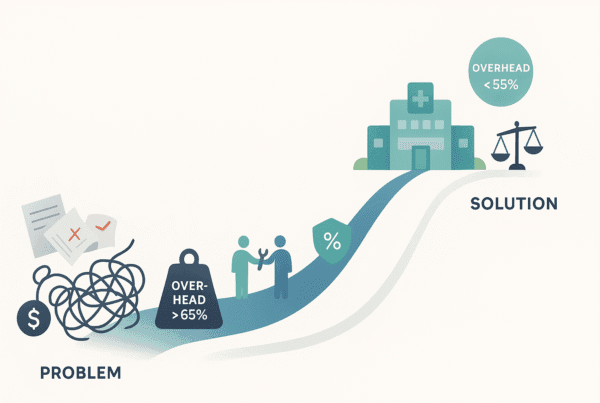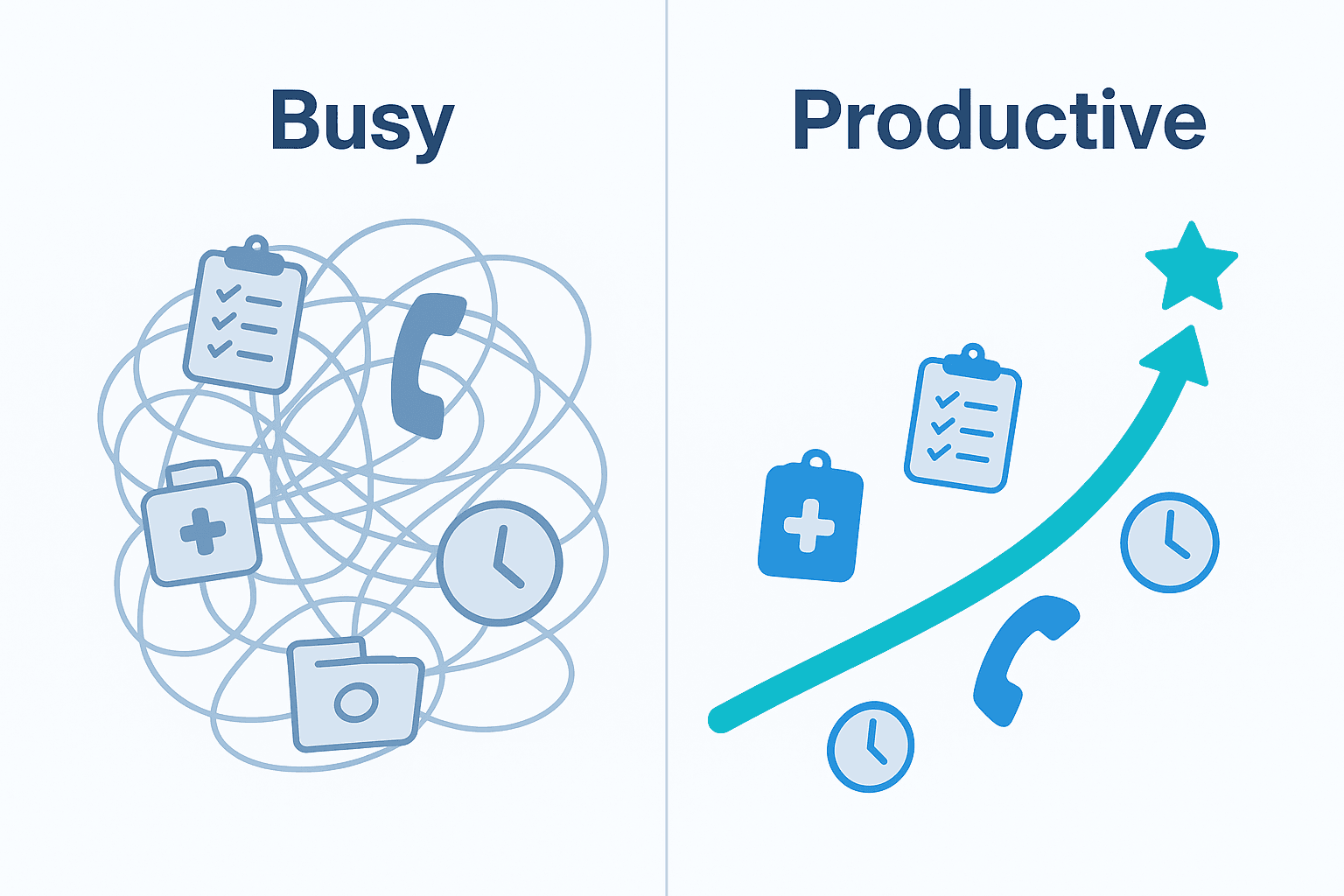
Understanding the operational, clinical, and financial transformations that reshape your practice post-sale
Table of Contents
- Beyond the Handshake: What Really Happens After the Sale
- The Integration Reality Check: Timeline and Phases
- Operational Transformation: The New Normal
- Clinical Integration: Balancing Quality with Consistency
- Financial and Legal Framework Evolution
- Employment Structure Transformation
- Technology Integration: The Biggest Operational Hurdle
- Preserving Practice Identity While Embracing Change
- Setting Yourself Up for Post-Acquisition Success
Beyond the Handshake: What Really Happens After the Sale
You’ve signed the papers, shaken hands, and celebrated the successful sale of your practice. But if you’re wondering what comes next—beyond the financial windfall—you’re asking the right question.
The reality is that selling your practice marks the beginning, not the end, of a complex transformation process. Post-acquisition changes extend far beyond simple ownership transfer to fundamentally reshape how your practice operates, how care is delivered, and how physicians and staff work day-to-day.
Whether you’re a practice owner who has recently sold, a physician employed by an acquired practice, or a practice administrator managing integration, understanding these changes is essential for navigating the transition successfully. The scope of transformation typically involves:
- Operational restructuring that affects everything from billing to staff management
- Clinical integration that standardizes care delivery and quality metrics
- Financial and legal framework changes that ensure compliance while optimizing performance
- Employment relationship modifications that reshape compensation and autonomy
- Technology integration challenges that can temporarily disrupt workflows
Research shows that some integration components can take anywhere from six months to five years to fully implement, making this a marathon rather than a sprint.
The key to success? Understanding what’s coming and preparing accordingly. Let’s dive into the specifics.
The Integration Reality Check: Timeline and Phases
What Changes When? A Realistic Timeline
One of the biggest sources of anxiety post-acquisition is uncertainty about timing. When will systems change? How long will disruption last? Here’s what you can realistically expect:
| Phase | Timeline | Key Changes |
|---|---|---|
| Immediate (Day 1-90) | Upon closing | New billing systems, basic reporting requirements, ownership transition |
| Short-term (3-12 months) | First year | Workflow standardization, staff integration, initial EMR modifications |
| Long-term (1-5 years) | Ongoing | Full clinical integration, comprehensive technology implementation, culture alignment |
Why Some Changes Happen Immediately
Billing system transitions occur on Day 1 because they directly affect revenue capture and compliance. The acquiring organization can’t afford gaps in cash flow or regulatory adherence, so these systems are typically switched immediately upon acquisition completion.
Administrative reporting requirements also change quickly, as the new parent organization needs visibility into practice performance from the outset. This includes financial reporting, productivity metrics, and basic operational dashboards.
The Long Game: Why Full Integration Takes Years
Clinical integration and technology implementation take substantially longer because they affect patient care quality and physician workflows. Successful organizations balance the need for standardization with the reality that rushed changes can compromise care delivery.
The complexity varies significantly based on practice size and organizational structure. Multi-location practices with established systems often face more complex integration challenges than smaller, single-location practices.
Operational Transformation: The New Normal
Immediate Administrative Changes
The first changes you’ll notice affect the business side of your practice. New billing systems and revenue cycle management processes become effective immediately, often requiring staff training and adaptation to different coding standards and documentation requirements.
Financial reporting obligations expand significantly post-acquisition. Where you may have previously operated with basic profit and loss statements, acquired practices typically must provide detailed analytics on physician productivity, operational efficiency metrics, and department-level performance data.
Workflow and Process Standardization
Standardization is the name of the game in post-acquisition integration. The acquiring organization will implement consistent procedures across all locations, affecting everything from patient scheduling systems to clinical documentation requirements.
This standardization process often involves:
- Adopting new clinical protocols that align with organizational quality standards
- Implementing uniform quality metrics across all practice locations
- Establishing consistent supply chain management and vendor relationships
- Harmonizing billing procedures and documentation standards
Staff Integration: The Human Element
Staff integration presents one of the most sensitive aspects of post-acquisition changes. Employment arrangements for non-physician staff often require careful negotiation, with assurance of employment frequently becoming a key issue in reaching acquisition agreements.
The human resources integration process involves:
- Harmonizing benefit packages and performance evaluation criteria
- Providing comprehensive training on new systems and procedures
- Addressing staff concerns about job security and role changes
- Maintaining patient care continuity throughout the transition
Successful staff integration often determines the overall success of the acquisition, as experienced personnel are essential for maintaining patient relationships and operational knowledge.
To learn more about specific operational changes, check out our detailed guide on Operational Changes After Sale.
Clinical Integration: Balancing Quality with Consistency
The Shift in Care Delivery Models
Clinical integration represents perhaps the most significant shift physicians experience post-acquisition. This process involves standardizing care protocols, implementing evidence-based treatment guidelines, and establishing consistent quality metrics that align with the acquiring organization’s clinical standards.
The transition often requires physicians to adapt their practice patterns to conform to new clinical guidelines and performance expectations. This can create tension, particularly for physicians who have developed successful approaches over years of independent practice.
Referral Network Management: A Major Change
Post-acquisition referral network changes often represent one of the most challenging aspects of clinical integration. The acquiring organization typically expects physicians to utilize internal specialists when possible, creating potential conflicts with established referral relationships.
This expectation can create challenges when:
- Physicians believe external specialists may provide superior care for specific conditions
- Patients have strong preferences for continuing with established providers
- Geographic convenience favors external referrals
Quality Metrics and Performance Standards
The implementation of new quality metrics represents a significant shift for practices transitioning from independent operation to integrated health system employment. Acquired practices must adapt to comprehensive performance measurement systems that may include:
- Clinical quality indicators and patient safety metrics
- Patient satisfaction scores and experience measures
- Financial performance metrics and operational efficiency indicators
- Value-based care metrics and population health indicators
These performance standards often extend beyond traditional productivity measures to include care coordination effectiveness and population health management—metrics that were previously managed at the system level.
To learn more about managing clinical integration challenges, check out our detailed guide on Clinical Integration Explained.
For strategies on preserving your clinical decision-making authority, see our guide on Maintaining Clinical Autonomy Post-Sale.
Financial and Legal Framework Evolution
Enhanced Financial Reporting Requirements
Post-acquisition financial changes create fundamental shifts in how practices manage revenue, expenses, and reporting obligations. The transition to new billing systems occurs immediately upon acquisition completion, requiring rapid adaptation to different coding standards and revenue cycle management processes.
The integration of financial systems frequently requires substantial staff training and process modification to ensure accurate revenue capture and compliance with new reporting requirements. Practices must adapt to potentially different payor mix management strategies and financial performance targets that align with the acquiring organization’s broader objectives.
Regulatory Compliance: Stricter Standards
Acquired practices must navigate an increasingly complex regulatory environment that includes substantial financial penalties, exclusion from federal healthcare programs, and even criminal charges for compliance violations. The Stark Law and Anti-Kickback Statute govern financial relationships and referral practices, with the goal of protecting patients from conflicts of interest and ensuring ethical medical care.
The Stark Law and Anti-Kickback Statute create particularly stringent requirements for healthcare organizations. Stark Law prohibits physicians from referring patients to receive “designated health services” (DHS) payable by Medicare or Medicaid from entities with which they, or an immediate family member, have a financial relationship. The Anti-Kickback Statute prohibits offering, paying, soliciting, or receiving anything of value to induce referrals for services or items covered by federal healthcare programs, such as Medicare and Medicaid.
These regulations require continuous monitoring and documentation to ensure ongoing compliance throughout the integration process. With the increasing number of healthcare mergers and acquisitions, facilities need to pay due diligence to uncover and resolve any possible Stark Law or other regulatory violations with a possible acquisition and ensure compliance going forward.
State-Specific Compliance Considerations
Compliance obligations extend beyond federal regulations to include state-specific requirements. The Corporate Practice of Medicine (CPOM) doctrine varies significantly across jurisdictions and can impact the structure of employment relationships and professional service arrangements post-acquisition.
To learn more about managing compliance requirements, check out our detailed guides on Financial Reporting Changes, Navigating Stark Law & Anti-Kickback, and Corporate Practice of Medicine Doctrine.
Employment Structure Transformation
From Partnership to Employment: Contract Essentials
Physician employment contracts in post-acquisition scenarios require careful attention to terms that may significantly differ from previous partnership arrangements. Contract terms typically include specific duration requirements, automatic renewal provisions, and termination clauses that reflect the acquiring organization’s employment policies rather than the flexible arrangements that existed in independent practice.
These employment agreements must address complex issues including:
- Work hour expectations and call coverage responsibilities
- Participation in organizational activities beyond direct patient care
- Restrictive covenants and non-compete provisions that may limit future practice options
- Compensation guarantee periods that provide income protection during transition
Compensation Model Evolution
The transition from independent practice compensation models to employed physician compensation structures represents one of the most significant changes physicians experience post-acquisition. Many independent practices operate on productivity-based formulas that directly link physician income to individual revenue generation, while employed models typically incorporate multiple performance metrics.
These new compensation models often include:
- Quality measures and patient satisfaction scores
- Care coordination activities and population health metrics
- Value-based care incentives tied to patient outcomes
- Compliance with fair market value requirements under Stark Law
Compensation guarantee periods typically range from one to three years, with more recent acquisitions offering shorter guarantee periods than earlier transactions. This transition often occurs over a two-year period, allowing physicians to gradually adapt to new performance expectations.
Professional Services Agreements: An Alternative Structure
Professional Services Agreements (PSAs) provide alternative structures for maintaining physician relationships post-acquisition while preserving some degree of practice independence. These agreements allow hospitals and health systems to contract for specific professional services including coverage responsibilities, medical directorships, and specialized clinical services without requiring full employment relationships.
PSAs must be carefully structured to ensure compliance with fair market value requirements and avoid any appearance of payment for referrals. All PSA arrangements must undergo careful legal review to ensure compliance with federal and state regulations.
To learn more about employment structure changes, check out our detailed guides on Physician Employment Contracts Guide, Professional Services Agreements (PSAs), and Physician Compensation Models Post-PE.
Technology Integration: The Biggest Operational Hurdle
EMR System Challenges and Timeline
Technology integration represents one of the most complex and time-consuming aspects of post-acquisition changes, particularly when dealing with electronic medical record (EMR) systems that may be incompatible between organizations. Data compatibility issues arise when different EMR systems store information in varying formats, requiring sophisticated conversion processes to ensure seamless data transfer.
The challenges include:
- Different coding standards across systems requiring comprehensive mapping
- Data security protocol updates to maintain compliance during migration
- Workflow disruptions during the transition period
- Training requirements for new system interfaces and procedures
Implementation Timeline and Training
EMR integration can take many months to complete effectively, and even years before acquired practices fully utilize all system capabilities. During this transition period, practices may need to maintain dual systems or implement temporary workarounds that can create workflow inefficiencies.
The implementation process often involves:
- Phased rollouts that gradually introduce new system features
- Comprehensive training programs addressing technical operation and clinical workflows
- Temporary productivity decreases as staff adapts to new systems
- Delayed performance metrics until systems are fully operational
Security and Compliance During Integration
Technology integration must address stringent security and compliance requirements that protect patient health information while ensuring system accessibility. The integration process requires careful evaluation of security protocols to ensure data protection standards meet regulatory requirements throughout the transition period.
To learn more about technology challenges, check out our detailed guide on Technology & EMR Integration Challenges.
Preserving Practice Identity While Embracing Change
Balancing Independence with Integration
The preservation of clinical autonomy while achieving operational integration represents one of the most delicate aspects of post-acquisition management. Physicians often express concerns about losing professional independence and clinical decision-making authority when transitioning from independent practice to employed status.
Successful integration requires finding an appropriate balance that allows for organizational standardization while preserving the clinical autonomy that enables physicians to provide optimal patient care. Research suggests that organizational autonomy should be viewed as a dynamic element that can be adjusted over time rather than a fixed characteristic established at acquisition.
Strategies for Maintaining Clinical Culture
The most successful acquisitions often involve:
- Negotiated autonomy arrangements that provide physicians with meaningful input into clinical protocols
- Ongoing dialogue between acquiring organizations and physician leaders
- Gradual integration approaches that monitor physician satisfaction and patient outcomes
- Preservation of practice identity while achieving operational efficiencies
Long-term Strategic Positioning
Successful post-acquisition integration requires long-term strategic planning that addresses evolving healthcare market conditions and regulatory requirements. Organizations must balance immediate integration objectives with long-term strategic positioning that preserves competitiveness and clinical excellence.
The dynamic nature of healthcare delivery models necessitates flexible integration approaches that can adapt to changing circumstances over time. Future success depends on the ability to maintain organizational identity and clinical culture while achieving the strategic objectives that motivated the acquisition.
To learn more about preserving autonomy, check out our detailed guide on Maintaining Clinical Autonomy Post-Sale.
Setting Yourself Up for Post-Acquisition Success
Proactive Communication Strategies
Clear, ongoing communication is essential for navigating post-acquisition changes successfully. Establish regular dialogue with new management teams, ask questions about timeline expectations, and voice concerns before they become problems. The most successful transitions involve physicians who actively engage in the integration process rather than passively waiting for changes to happen.
Building Relationships with New Leadership
Take the initiative to understand your new organizational structure and build relationships with key stakeholders. This includes not just direct supervisors but also compliance officers, IT support teams, and clinical quality leaders who will influence your day-to-day experience.
Leveraging Resources and Opportunities
Post-acquisition often brings access to resources that weren’t available in independent practice. This might include advanced technology systems, specialized support staff, continuing education opportunities, or research capabilities. Successful physicians learn to leverage these resources to enhance their practice while maintaining quality patient care.
Planning for Long-term Career Goals
Consider how post-acquisition changes align with your long-term career objectives. Whether that involves leadership opportunities within the larger organization, specialized clinical roles, or eventual transition to different practice settings, understanding the new landscape helps you make strategic career decisions.
The post-acquisition transformation of medical practices represents a complex but manageable process when you understand what’s coming and prepare accordingly. While the scope of changes can seem overwhelming, successful navigation depends on maintaining focus on patient care while adapting to new operational realities.
Remember that integration is a marathon, not a sprint. Some changes happen immediately, others take years to fully implement. The key is understanding the timeline, communicating proactively, and viewing the transition as an opportunity to enhance rather than diminish your practice capabilities.
If you’re facing a post-acquisition transition or considering a sale, understanding these implications is crucial for making informed decisions about your practice’s future. At SovDoc, we help practice owners navigate both the sale process and post-acquisition planning to ensure successful outcomes.
Ready to explore your options or need guidance on post-acquisition planning? Contact our team for a comprehensive consultation on how these changes might affect your specific situation and goals.



